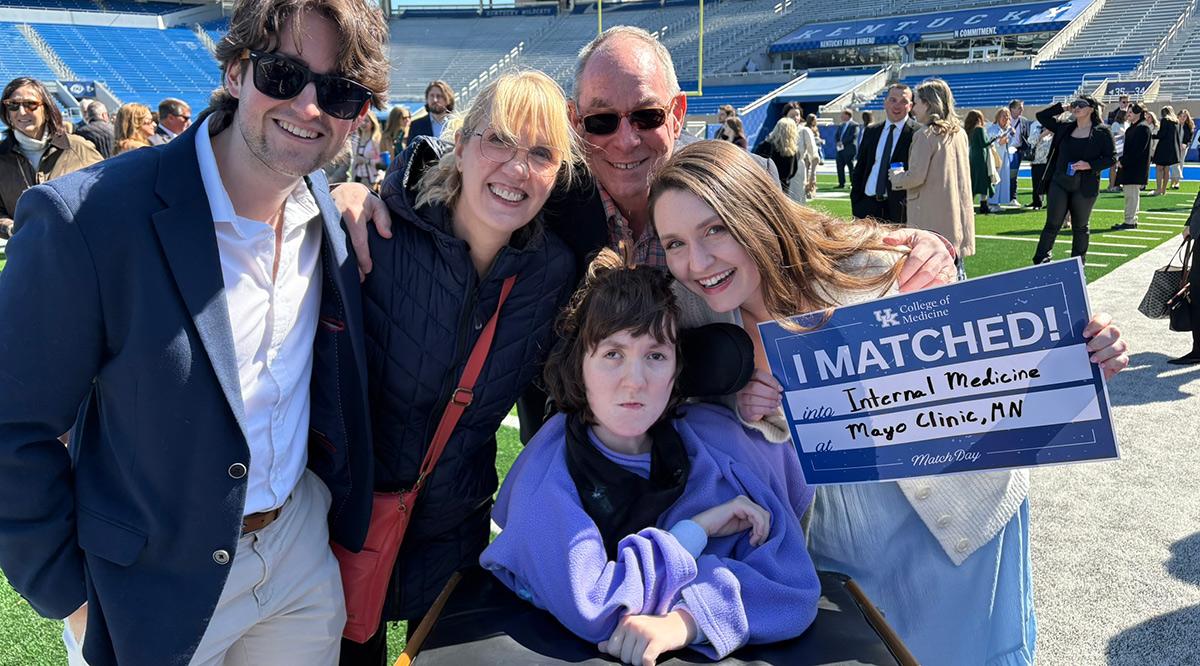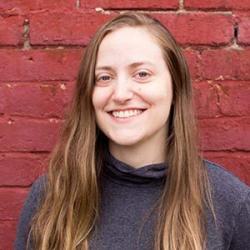Each May, thousands of medical students celebrate a major milestone — crossing the stage to receive their hard-earned MD degrees.
It’s an amazing accomplishment for all, but for some, it’s one they may not have achieved had they not overcome immense barriers.
From surviving a life-threatening camping accident to fleeing devastating wildfires while completing rotations, these five graduating medical students share their journeys to graduation.
Catherine Lawton, MD
University at Buffalo (UB) Jacobs School of Medicine and Biomedical Sciences, in New York
Residency: Transition year at OhioHealth Riverside Methodist Hospital, in Columbus; physical medicine and rehabilitation, University of Washington, Seattle
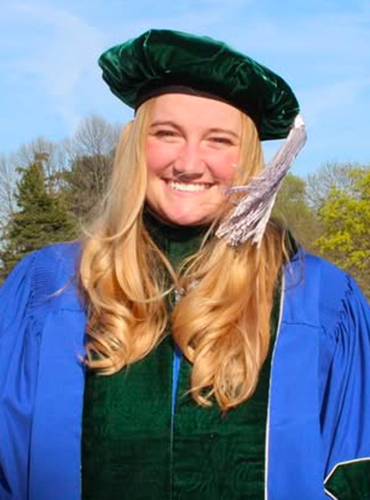
Catherine Lawton, MD
Courtesy of Catherine Lawton, MD
Catherine Lawton, MD, was obsessed with science from a young age. She recalls asking for litmus paper as a child so she could test and trend the acidity of the creek behind her home. That natural curiosity combined with the caregiving responsibilities she developed as the oldest of seven children made medicine a natural career path for her. She majored in biomedical engineering at Case Western Reserve University in Cleveland and was on track to start medical school when her plans were disrupted.
While on a camping trip with friends during the September of her senior year of college, a massive oak tree fell on her tent.
“I knew immediately that I was severely injured. It trapped me under the tent,” Lawton recalls. “I was checking my arms and legs, and I couldn’t feel my left leg move. That’s when I said, ‘I think I broke my back.’”
Lawton was taken by helicopter to a hospital in Kentucky, where doctors moved quickly to assess her numerous injuries: a broken pelvis and ribs, two punctured lungs, various internal injuries that resulted in a partial bowel removal, and a back broken in 10 places.
“I was grateful to have survived,” she says.
Lawton spent a month in the Kentucky ICU and then another month at the Cleveland Clinic, where she focused on rehabilitation.
Her recovery required her to take a semester off from school, delaying her graduation.
Still, Lawton was never deterred from following her dreams. In fact, she used her hiatus from school to learn adaptive skiing and pushed forward with her medical school interviews. When interviewing at UB — the program she ultimately attended — she became fatigued. One of her interviewers, the late Jonathan Daniels, MD, found a hospital bed where she was able to lie down while she completed the interview.
“UB took a chance on me,” Lawton says.
She started medical school two years after the accident and was relieved and grateful about how accommodating the medical school faculty, her fellow students, and even the patients were to her disability. During her first year of school, she used a wheelchair. During her last three years, she walked with forearm crutches and would sometimes experience extreme fatigue.
“Patients joked with me, saying, ‘Do you want my chair?’ and I’d respond, ‘Don’t tempt me,’” Lawton recalls with a smile.
While on her surgery rotation, Lawton trained for a 5K race, to build up her speed and stamina so she could keep up with the surgeons. She also worked with the chair of surgery to develop and publish a novel protocol to ensure she could participate in surgery in a sterile way while using her forearm crutches.
It was important to her to experience every rotation fully, especially after completing what she called her inpatient rotation — her 10-week hospital stay after the accident.
“My time as a patient was the most important course I took,” Lawton says. It also further deepened her resolve to pursue a career in physical and rehabilitation medicine.
“It’s very full circle,” she says. “Having been a patient, it’s a privilege to be there for other people at such a hard time in their lives.”
When Lawton graduated from medical school on May 2, 2025, she accomplished yet another milestone. After a year of working toward the goal in physical therapy, she walked across the stage using only a cane. It was the first time her classmates saw her without crutches, and they cheered her enthusiastically every step of the way.
Jesus Eduardo Fuentes, MD
Kaiser Permanente Bernard J. Tyson School of Medicine (KPSOM), in Pasadena, California
Residency: Neurology, University of California, Davis School of Medicine
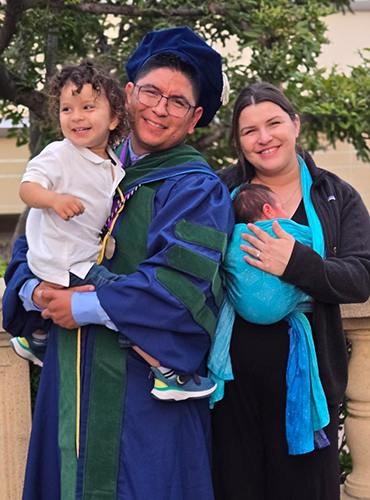
Jesus Eduardo Fuentes, MD, poses with his partner, Tabitha Kirkendall, and their two sons at his medical school graduation.
Courtesy of Jesus Eduardo Fuentes, MD
In January 2025, as Jesus Eduardo Fuentes, MD, was beginning his final semester of medical school, a fire began spreading through the San Gabriel Mountains near Los Angeles. Fuentes and his partner, Tabitha Kirkendall, who was six months pregnant at the time, made the call to take their 2-year-old son and dog and flee their home in Altadena before the official evacuation order was issued. They all arrived safely to stay with family, but their rental home was damaged — and their community devastated — by the Eaton fire, which has since been deemed the second-most-destructive wildfire in California history.
“It was scary in the moment, and I’m thankful that we got out safe,” Fuentes says. “There are a lot of folks who weren’t as fortunate, who lost homes and loved ones. Seeing the devastation was heartbreaking.”
It wasn’t the first time Fuentes had lived through a natural disaster. Between college and medical school, Fuentes spent several years teaching – first in South Dakota with Oglala Lakota Nation students as part of Teach for America, then as an English teaching assistant as part of the Fulbright-Garcia Robles program in Mexico City. In 2017, he was teaching a class at the school in Mexico City when a 7.1 magnitude earthquake hit the city. Fuentes says he was able to help lead some students to safety, but the experience of seeing the loss of life and physical devastation caused by the earthquake stays with him.
“It’s something I remember in flashes — helping direct my students to safety and how much chaos the earthquake caused,” he says. “It left a mark.”
All these experiences have instilled in Fuentes a sense of awe for the resilience and community spirit that can help bring people through a myriad of challenges. They also remind him of his commitment to giving back to the community.
“Each of those moments and experiences has improved me — not just as a physician, but they’ve also made me a better human being,” he says. “Being able to be in those different settings — rural, urban, different countries, communities — gave me insight into how we need to make sure we’re not just achieving equity, but also achieving justice. They’ve informed the systemic work and policy work I’d like to do in the future.”
Susanna Goggans, MD
University of Kentucky College of Medicine, in Lexington
Residency: Internal medicine, Mayo Clinic, in Rochester, Minnesota
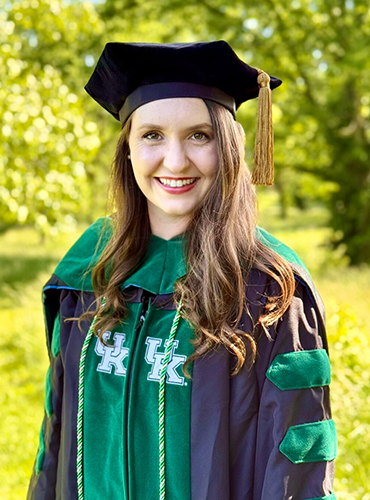
Susanna Goggans, MD
Courtesy of Susanna Goggans, MD
During her freshman year of college at the University of Kentucky, Susanna Goggans, MD, had serious doubts she’d ever fulfill her dream of graduating from medical school. Growing up in a small town in Kentucky and spending much of her formative years helping to care for her younger sister, who has cerebral palsy, Goggans decided early on that she wanted to become a doctor. But the adjustment to city life and college shook her self-confidence. On top of those struggles, during the summer following her freshman year, Goggans’ mother was diagnosed with ovarian cancer.
“My first reaction was anger,” Goggans recalls. “She had always done everything right. She was very healthy and takes care of herself. Why did this happen to her?”
Fortunately, the cancer was found early — Stage 1 — thanks to a screening program at the University of Kentucky. Though that summer was trying, as Goggans took on more caregiving responsibilities for her sister while her mother went through chemotherapy, she was grateful to know that her mom had a great prognosis. By that Christmas, her mom was cancer-free.
The experience of seeing her mom go through cancer treatment gave Goggans the push she needed to commit to her future as a physician. She joined the Markey Cancer Center’s Appalachian Career Training in Oncology (ACTION) program, which gave her the opportunity to do cancer research and outreach to people in her home region of Appalachia, where there are disproportionately high cancer incidence and mortality rates.
Throughout medical school, she drew on her experience as a caregiver to connect with the patients she encountered during her rotations.
“It gives me a whole lot of empathy,” Goggans says. “I saw the importance of explaining things to the patient and giving them time. We’re so busy as doctors, but that’s very important. I know how much it can impact the patient if they feel that their doctor really cares.”
Jacob Abrahams, MD
Kaiser Permanente Bernard J. Tyson School of Medicine (KPSOM)
Residency: Internal medicine, Icahn School of Medicine at Mount Sinai, in New York City
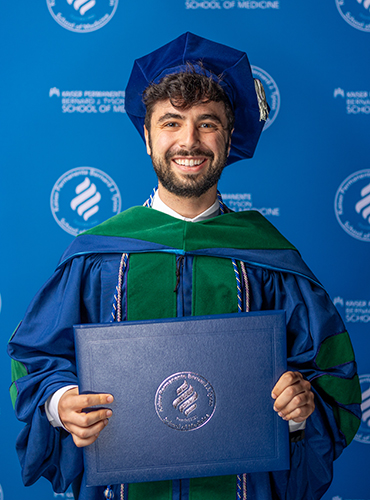
Jacob Abrahams, MD
Courtesy of Kaiser Permanente Bernard J. Tyson School of Medicine
Just a few months before he was set to matriculate into medical school, Jacob Abrahams, MD, was faced with a harrowing diagnosis: He had a potentially aggressive brain tumor.
The Pennsylvania native had been visiting KPSOM in Pasadena, California, to determine if he wanted to attend medical school there when he noticed that his vision was off. He went to an eye doctor who prescribed some drops, but his vision didn’t improve. After he was back in New York City, where he had been working in a clinic for LGBTQ+ patients, his vision worsened to the point that he couldn’t read patient charts. He then saw a neurologist, who had him get an MRI, which found a mass on his brain.
The imaging suggested he could have an aggressive glioma.
“There was this discussion with myself: ‘If I only have limited time, would I want to go to medical school and residency?’” Abrahams recalls. “I settled, even at that time, that this is something I would want to do with the time I had left.”
Fortunately, further exploration revealed that the tumor was, in fact, a rare pediatric glioma that was completely curable. He had surgery in May 2021, and after recuperating for a couple of months, started medical school at KPSOM in the fall.
Abrahams says that the experience has shaped the way he relates to patients, now being on the other side of a difficult diagnosis.
“I’m astutely aware of how much patients lean on what physicians say,” he says.
As he prepares to start his internal medicine residency at the Icahn School of Medicine at Mount Sinai, he’s excited to take full ownership of treating his patients and providing “whole-person care.”
Perpetuah Sherman, MD, PharmD
University of Texas Southwestern Medical School, in Dallas
Residency: Anesthesiology, UT Southwestern
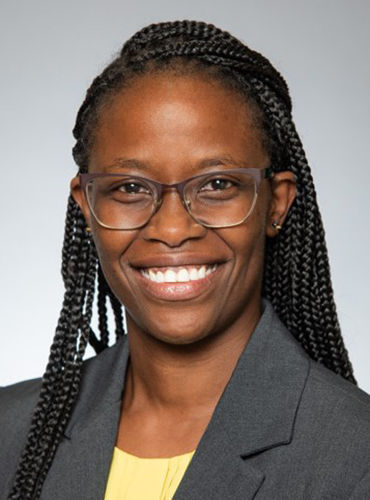
Perpetuah Sherman, MD, PharmD
Courtesy of Perpetuah Sherman, MD, PharmD
Growing up in Kenya, Perpetuah Sherman, MD, PharmD, spent her formative years watching her mother, a pharmacist, care for the people in their community.
“Mom would listen to the symptoms — she knew what would treat what — and I saw patients be grateful for the relief she provided,” Sherman recalls. “I was enamored by the whole beginning-to-end process.”
Sherman and her family moved to Texas when she was 18 and, unfamiliar with the health care system in the United States, she set out to become the kind of pharmacist her mother was. She completed pharmacy school and spent about a decade working as a pharmacist, but she felt unfulfilled.
“I was always on the tail end of it,” she says. “Someone else had made the decision — I was just fulfilling that decision. I felt like I was missing out.”
But the prospect of upending her career and starting medical school while raising three children was intimidating.
“In my mind, it was a huge leap and big sacrifice to have done all that [pharmacy school and career] and then say I want to go back to school,” she says.
However, one harrowing experience, which took place when she was giving birth to her second child, stayed with her. She’d received an epidural, but due to an error, her entire body went numb. She couldn’t communicate with her health care providers, who, worried she was in distress, called a code blue. Sherman, who was aware of her surroundings, was terrified that the shock of a defibrillator might hurt her baby. Then, the anesthesiologist came into the room, promptly checked her vitals, and realized the problem. The medical team rushed her to the OR to perform a cesarean section. Thankfully, Sherman and her baby were unharmed, but she never forgot how the anesthesiologist’s expertise and quick action made all the difference.
“It’s what got me even more interested in medicine; I wanted to be that person for somebody else,” she says. It’s one of the things that led her to pursue a residency in anesthesiology.
Her children are now 15, 12, and 8, and although she experienced “mom guilt” for having to keep up with the demands of medical school while parenting, she can now see how her tenacity has inspired her children to push themselves when they face obstacles.
“It’s the reason they are more resilient and willing to keep going even when they’re bogged down,” she says.
As Sherman graduates from medical school, she reflects on how glad she is that she took the leap and dared to make a career change, despite the challenges.
“You start to discover a whole new version of you that you didn’t know existed,” she says. “That is beautiful.”
